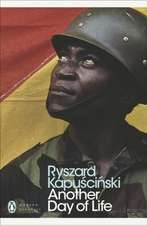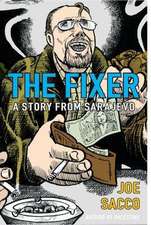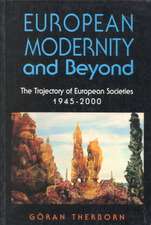Kent State: Death and Dissent in the Long Sixties: Culture and Politics in the Cold War and Beyond
Autor Thomas M. Graceen Limba Engleză Paperback – 24 feb 2016
On May 4, 1970, National Guard troops opened fire on unarmed antiwar protesters at Kent State University in Ohio, killing four students and wounding nine others, including the author of this book. The shootings shocked the American public and triggered a nationwide wave of campus strikes and protests. To many at the time, Kent State seemed an unlikely site for the bloodiest confrontation in a decade of campus unrest—a sprawling public university in the American heartland, far from the coastal epicenters of political and social change.
Yet, as Thomas M. Grace shows, the events of May 4 were not some tragic anomaly but were grounded in a tradition of student political activism that extended back to Ohio's labor battles of the 1950s. The vast expansion of the university after World War II brought in growing numbers of working-class enrollees from the industrial centers of northeast Ohio, members of the same demographic cohort that eventually made up the core of American combat forces in Vietnam. As the war's rising costs came to be felt acutely in the home communities of Kent's students, tensions mounted between the growing antiwar movement on campus, the university administration, and the political conservatives who dominated the surrounding county as well as the state government.
The deadly shootings at Kent State were thus the culmination of a dialectic of radicalization and repression that had been building throughout the decade. In the years that followed, the antiwar movement continued to strengthen on campus, bolstered by an influx of returning Vietnam veterans. After the war ended, a battle over the memory and meaning of May 4 ensued. It continues to the present day.
Yet, as Thomas M. Grace shows, the events of May 4 were not some tragic anomaly but were grounded in a tradition of student political activism that extended back to Ohio's labor battles of the 1950s. The vast expansion of the university after World War II brought in growing numbers of working-class enrollees from the industrial centers of northeast Ohio, members of the same demographic cohort that eventually made up the core of American combat forces in Vietnam. As the war's rising costs came to be felt acutely in the home communities of Kent's students, tensions mounted between the growing antiwar movement on campus, the university administration, and the political conservatives who dominated the surrounding county as well as the state government.
The deadly shootings at Kent State were thus the culmination of a dialectic of radicalization and repression that had been building throughout the decade. In the years that followed, the antiwar movement continued to strengthen on campus, bolstered by an influx of returning Vietnam veterans. After the war ended, a battle over the memory and meaning of May 4 ensued. It continues to the present day.
Din seria Culture and Politics in the Cold War and Beyond
-
 Preț: 157.05 lei
Preț: 157.05 lei -
 Preț: 205.85 lei
Preț: 205.85 lei -
 Preț: 210.35 lei
Preț: 210.35 lei -
 Preț: 225.56 lei
Preț: 225.56 lei -
 Preț: 224.21 lei
Preț: 224.21 lei -
 Preț: 208.17 lei
Preț: 208.17 lei -
 Preț: 260.07 lei
Preț: 260.07 lei -
 Preț: 296.71 lei
Preț: 296.71 lei -
 Preț: 277.16 lei
Preț: 277.16 lei -
 Preț: 300.35 lei
Preț: 300.35 lei -
 Preț: 291.90 lei
Preț: 291.90 lei -
 Preț: 293.04 lei
Preț: 293.04 lei -
 Preț: 294.41 lei
Preț: 294.41 lei -
 Preț: 296.71 lei
Preț: 296.71 lei -
 Preț: 274.83 lei
Preț: 274.83 lei -
 Preț: 193.85 lei
Preț: 193.85 lei -
 Preț: 224.60 lei
Preț: 224.60 lei -
 Preț: 241.09 lei
Preț: 241.09 lei -
 Preț: 242.05 lei
Preț: 242.05 lei -
 Preț: 216.05 lei
Preț: 216.05 lei - 7%
 Preț: 183.94 lei
Preț: 183.94 lei -
 Preț: 208.59 lei
Preț: 208.59 lei - 15%
 Preț: 564.69 lei
Preț: 564.69 lei -
 Preț: 189.41 lei
Preț: 189.41 lei - 15%
 Preț: 570.06 lei
Preț: 570.06 lei -
 Preț: 215.42 lei
Preț: 215.42 lei -
 Preț: 222.08 lei
Preț: 222.08 lei -
 Preț: 246.55 lei
Preț: 246.55 lei -
 Preț: 250.24 lei
Preț: 250.24 lei
Preț: 235.15 lei
Nou
Puncte Express: 353
Preț estimativ în valută:
44.100€ • 47.10$ • 37.45£
44.100€ • 47.10$ • 37.45£
Carte disponibilă
Livrare economică 10-24 martie
Preluare comenzi: 021 569.72.76
Specificații
ISBN-13: 9781625341112
ISBN-10: 1625341113
Pagini: 416
Ilustrații: 32 b&w photos in 2 galleries
Dimensiuni: 156 x 235 x 28 mm
Greutate: 0.59 kg
Ediția:First Edition
Editura: University of Massachusetts Press
Colecția University of Massachusetts Press
Seria Culture and Politics in the Cold War and Beyond
ISBN-10: 1625341113
Pagini: 416
Ilustrații: 32 b&w photos in 2 galleries
Dimensiuni: 156 x 235 x 28 mm
Greutate: 0.59 kg
Ediția:First Edition
Editura: University of Massachusetts Press
Colecția University of Massachusetts Press
Seria Culture and Politics in the Cold War and Beyond
Notă biografică
Thomas M. Grace is adjunct professor of history at Erie Community College. A 1972 graduate of Kent State University, he earned a PhD in history from SUNY Buffalo after many years as a social worker and union representative.
Recenzii
"Tom Grace has written a deep study of one local, very all-American site of radicalization over the longue durée from the early 1950s to the mid–1970s. There is nothing else like it. It's must reading for anyone concerned with the New Left and postwar political change."—Van Gosse, author of Rethinking the New Left: An Interpretative History
"A work of genuine scholarly importance—the most complete account of the Kent State events to date."—Maurice Isserman, author of If I Had a Hammer: The Death of the Old Left and the Birth of the New Left
"Grace writes with commitment or passion, but with remarkable equanimity. Neither he nor his fellow student activists appear as victims, but rather as combatants in a desperate struggle. Their adversaries are not portrayed as villains, but as combatants on the other side with their own views and goals. . . The result of Grace's study is a systematic deconstruction of many media-generated myths that were immediately projected onto the Kent State shootings and persist as a battle over the memory and meaning of May 4 that continues to the present day."—Talking Union
"Thomas M. Grace has written a comprehensive, evenhanded, and massively researched history of the Kent State struggle."—Boulder Weekly
"Grace criticizes university administrators for their consistently negative attitude toward protest and is sympathetic toward his colleagues who did protest. And he clearly sees the Ohio National Guard firing on students as a criminal act. The research is exhaustive, with 90 pages of notes, many basted on interviews. Recommended."—Choice
"In his finely detailed and engagingly written study of Kent State University, Thomas M. Grace has made a major scholarly contribution. Although a participant in some of the events he describes (indeed, the Ohio National Guard caught him in its cross fire on May 4, 1970), Grace provides an evenhanded analysis."—Journal of American History
"Grace has made an outstanding contribution to the historiography of the antiwar movement. . . . Newspapers, in particular the Daily Kent Stater, are put to excellent use. Most impressive, however, is Professor Grace's use of forty-four oral history interviews, some of which would not have been available to him except for his insider credentials--on May 4, 1970, Grace was shot by Ohio National Guardsmen."—Labour/Le Travail
"This important scholarly work is not only an informative read for all wanting to learn more of this time in our country's history. It is a most valuable learning tool for our high schools, colleges, and universities. I encourage all who are interested this history, and even whose who are not, to read this book. You will not be disappointed."—The Veteran
"Kent State provides a corrective to the image of the 1960s at Kent State, specifically, but beyond that, it explains the process of movement development, radicalization, and repression among mostly working class, Midwestern students. This focus makes the study unique and insightful among scholarship that is generally focused on the more iconic centers of protest."—Michigan Historical Review
"Grace's work gives readers an accounting of the events of May 1970 from multiple perspectives, recognizing that non e of them are entirely adequate in capturing that tragic day. In doing so, he fulfills his book's promise and, at the same time, offers a model for combining local, regional, and national stories into a complete and satisfying narrative."—The Sixties
"Thomas Grace has written the definitive book on the killing of four Kent State students during the Vietnam war. . . . As the counter culture grows, the rebellious character of the movement grows. At times there is black and white unity, at other times minority and antiwar concerns take their own paths. Grace manages to weave all this into a highly readable and enlightening story. A real strength of this book is that it introduces us to a score of individuals their motivations and actions, while never losing sight of the bigger picture. . . . If you teach, assign this book to your students. If you have kids, buy this book for their birthday. And, for yourself, read this book to understand the world of the 1960s and what makes America, America."—Race Class
"Invigorating and revelatory. . . . It is unlikely that we will see another book about Kent State's protest culture that is as well conceived and thoroughgoing as this one."—American Historical Review
"A work of genuine scholarly importance—the most complete account of the Kent State events to date."—Maurice Isserman, author of If I Had a Hammer: The Death of the Old Left and the Birth of the New Left
"Grace writes with commitment or passion, but with remarkable equanimity. Neither he nor his fellow student activists appear as victims, but rather as combatants in a desperate struggle. Their adversaries are not portrayed as villains, but as combatants on the other side with their own views and goals. . . The result of Grace's study is a systematic deconstruction of many media-generated myths that were immediately projected onto the Kent State shootings and persist as a battle over the memory and meaning of May 4 that continues to the present day."—Talking Union
"Thomas M. Grace has written a comprehensive, evenhanded, and massively researched history of the Kent State struggle."—Boulder Weekly
"Grace criticizes university administrators for their consistently negative attitude toward protest and is sympathetic toward his colleagues who did protest. And he clearly sees the Ohio National Guard firing on students as a criminal act. The research is exhaustive, with 90 pages of notes, many basted on interviews. Recommended."—Choice
"In his finely detailed and engagingly written study of Kent State University, Thomas M. Grace has made a major scholarly contribution. Although a participant in some of the events he describes (indeed, the Ohio National Guard caught him in its cross fire on May 4, 1970), Grace provides an evenhanded analysis."—Journal of American History
"Grace has made an outstanding contribution to the historiography of the antiwar movement. . . . Newspapers, in particular the Daily Kent Stater, are put to excellent use. Most impressive, however, is Professor Grace's use of forty-four oral history interviews, some of which would not have been available to him except for his insider credentials--on May 4, 1970, Grace was shot by Ohio National Guardsmen."—Labour/Le Travail
"This important scholarly work is not only an informative read for all wanting to learn more of this time in our country's history. It is a most valuable learning tool for our high schools, colleges, and universities. I encourage all who are interested this history, and even whose who are not, to read this book. You will not be disappointed."—The Veteran
"Kent State provides a corrective to the image of the 1960s at Kent State, specifically, but beyond that, it explains the process of movement development, radicalization, and repression among mostly working class, Midwestern students. This focus makes the study unique and insightful among scholarship that is generally focused on the more iconic centers of protest."—Michigan Historical Review
"Grace's work gives readers an accounting of the events of May 1970 from multiple perspectives, recognizing that non e of them are entirely adequate in capturing that tragic day. In doing so, he fulfills his book's promise and, at the same time, offers a model for combining local, regional, and national stories into a complete and satisfying narrative."—The Sixties
"Thomas Grace has written the definitive book on the killing of four Kent State students during the Vietnam war. . . . As the counter culture grows, the rebellious character of the movement grows. At times there is black and white unity, at other times minority and antiwar concerns take their own paths. Grace manages to weave all this into a highly readable and enlightening story. A real strength of this book is that it introduces us to a score of individuals their motivations and actions, while never losing sight of the bigger picture. . . . If you teach, assign this book to your students. If you have kids, buy this book for their birthday. And, for yourself, read this book to understand the world of the 1960s and what makes America, America."—Race Class
"Invigorating and revelatory. . . . It is unlikely that we will see another book about Kent State's protest culture that is as well conceived and thoroughgoing as this one."—American Historical Review













